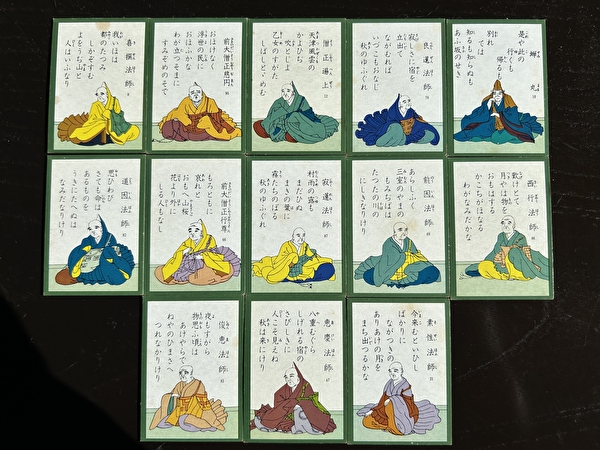「坊主めくり」
Do you know about Japanese card games? Bozu Mekuri is a simple card game played with the pictures of Yomifuda (cards for reading) from the Ogura Hyakunin Isshu deck. At 4T-AMKY, Teachers and Students write about Japanese culture, food, history, many spots to visit, and other stuff. Enjoy reading and knowing about deeper Japanese culture!
Bozu Mekuri
Origin of Ogura Hyakunin Isshu

Ogura Hyakunin Isshu is a collection of 100 waka poems selected by Teika Fujiwara (1162-1241), a poet of the late Heian and early Kamakura eras, at his villa on Mt. Ogura in Kyoto. In other words, it is an anthology of poems compiled by selecting 100 leading poets from ancient times to the early Kamakura era and collecting one waka poem from each.
It consists of 43 love poems, 32 seasonal poems, 4 travel poems, 1 separation poem, and 20 miscellaneous poems. The poems are not representative of each poet but rather a collection of poems favored by Teika, and many of them are said to be graceful and elegant.
This anthology of poems began to attract people’s attention around the middle of the Muromachi era (1338-1573), and was read by beginners in the art of poetry, used as an introduction to the classics, and has been enjoyed by many people.
Utagaruta

Ogura Hyakunin Isshu is known today to the general public as Utagaruta, played during the New Year. The Karuta cards are divided into Yomifuda (cards for reading), on which the whole waka poem is written, and Torifuda (cards for taking), on which only the lower part of the poem is written. There are 100 cards of each. The Yomifuda depict portraits of the authors of the waka poems.
This game is said to have started and spread among the ladies of the inner palace of Edo Castle. After the mid-Meiji era (around 1900), it became a New Year’s event as we know it today. In this game, the reader reads the cards in a recitation style, and the takers quickly take the cards that match the cards read. The winner is the one who has taken the most cards.
Bozu Mekuri
To play Utagaruta, you need to memorize each waka poem to play well, but there is also a game that uses only the pictures drawn on the cards for reading. That game is Bozu Mekuri (Bozu means a Buddhist priest, Mekuri means to flip). Among the hundred poets are Tono (man), Hime (woman), Ten’no (emperor), Bukan (warrior), and Bozu (Buddhist priest). You play with those patterns. How to play Bozu Mekuri is as follows.
A deck of one hundred Yomifuda (cards for reading) of Ogura Hyakunin Isshu is placed face down on the table as three piles.

Players flip one card at a time, in turn, and if it is a Tono (man) card, it is placed in front of them.

When you flip a card and it is a Bozu (Buddhist priest) card, you must put all of your cards next to the piles.

When you flip a card and it is a Hime (woman) card, you can receive all the cards that are put out next to the piles for yourself.

The game ends when the piles of cards run out. The winner is the player with the most cards remaining in front of him or her.
Rules
While card games usually have official rules set by manufacturers or organizations, there are no official rules for Bozu Mekuri, and the game is enjoyed according to various rules depending on the region or household.
In my family’s rules, there was another rule for how to receive the cards that were put out next to the piles.
If you flip a card and it is a Ten’no (emperor) card, you can receive ten cards.

If you flip a card and it is a Hime (woman) card, you can receive five cards.

If you flip a card and it is a Bukan (warrior) card with a bow and arrow, you can receive three cards.

Even if you are overjoyed to receive so many cards by flipping a card and it is a Hime or a Ten’no card, if you next flip a card and it is a Bozu card, you will lose all of your cards. This unexpected twist can happen to anyone, any number of times within a game. It is a game of thrills and great excitement.
Bozu Mekuri does not require memorization of waka poems, and can be played simply by flipping cards from the piles in order. As long as you don’t flip the Bozu card, anyone can win. Anyone can play right away, from children to adults, even foreigners who do not understand Japanese.
「坊主めくり」
小倉百人一首の由来
百人一首とは、平安時代末期から鎌倉時代初期の歌人、藤原定家(1162~1241)が、京都小倉山の山荘で選んだ百首の和歌のことです。すなわち、古代から鎌倉時代初期までの有力歌人、百人を選び,それぞれの和歌一首ずつを集めて編纂した詩歌集です。
恋歌43首、四季歌32首、旅歌4首、離別歌1首、雑歌20首からなっています。それぞれの歌人の代表作というわけではなく,定家好みの歌が集められていて、優雅で流麗な作が多いとされています。
この詩歌集は、室町中期頃から人々に注目されはじめ、歌道の入門者に読まれ、古典の入門書としても使用され、多くの人々に親しまれてきました。
歌がるた
小倉百人一首は、今日では正月に遊ぶ「歌がるた」として一般の人々に知られています。かるたの札は、和歌の全句を書いた「読み札」と、下の句だけの「取り札」に分かれています。それぞれ百枚ずつあります。読み札には和歌の作者の肖像画が描かれています。
この遊びは、江戸城大奥の御殿女中たちの間から始まり広がったのだそうです。明治中期以降に現在のような正月行事となりました。遊び方は,読み手が読み札を朗詠風に読み,取り手たちが、読み札に合った取り札を早く取り合います。最も多くの札を取ったものが勝者となります。
坊主めくり
「歌がるた」で遊ぶには、それぞれの和歌を覚えていないとうまく遊べませんが、読み札に描いてある絵だけを使う遊びもあります。それが「坊主めくり」です。百人の歌人には、殿(男性)、姫(女性)、天皇、武官、そして坊主がいます。その絵柄で遊びます。遊び方は、次の通りです。
小倉百人一首の百枚の読み札を裏返して積み重ね、三つの山札として場におきます。
参加者が順に一枚ずつめくり、殿札なら自分の前に置きます。
坊主札が出たら、手持ちの札のすべてを山札の横に出さなければなりません。
姫札が出たら、山札の横に出された札を全部自分のものにできます。
山札がなくなるとゲーム終了です。このとき自分の前に残った札が最も多い人が勝者となります。
ルール
カードゲームはメーカーや団体が公式ルールを定めているのが普通ですが、坊主めくりについては、公式ルールはなく、地域や家庭によって様々なルールで楽しまれているようです。
我が家のルールでは、山札の横に出された札のもらい方に別のルールがありました。
天皇札が出たら十枚もらえます。
姫札が出たら五枚もらえます。
弓矢を持つ武官札が出たら三枚もらえます。
札をめくった時に姫札や天皇札が出て、札をたくさんもらって大喜びしても、次にめくった時に坊主札が出れば、札が全部なくなります。このどんでん返しが何度でも、誰にでも起こります。ドキドキ大興奮のゲームです。
坊主めくりは、和歌を暗記する必要もなく、順番に山札の札をめくるだけで遊べます。坊主札さえめくらなければ誰にでも勝てる可能性があります。子供から大人まで、日本語がわからない外国の方でも誰でもすぐに遊ぶことができます。
Ikuyo.K.






